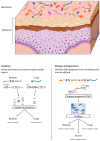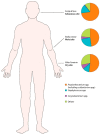Potential Role of the Microbiome in Acne: A Comprehensive Review
- PMID: 31284694
- PMCID: PMC6678709
- DOI: 10.3390/jcm8070987
Potential Role of the Microbiome in Acne: A Comprehensive Review
Abstract
Acne is a highly prevalent inflammatory skin condition involving sebaceous sties. Although it clearly develops from an interplay of multiple factors, the exact cause of acne remains elusive. It is increasingly believed that the interaction between skin microbes and host immunity plays an important role in this disease, with perturbed microbial composition and activity found in acne patients. Cutibacterium acnes (C. acnes; formerly called Propionibacterium acnes) is commonly found in sebum-rich areas and its over-proliferation has long been thought to contribute to the disease. However, information provided by advanced metagenomic sequencing has indicated that the cutaneous microbiota in acne patients and acne-free individuals differ at the virulent-specific lineage level. Acne also has close connections with the gastrointestinal tract, and many argue that the gut microbiota could be involved in the pathogenic process of acne. The emotions of stress (e.g., depression and anxiety), for instance, have been hypothesized to aggravate acne by altering the gut microbiota and increasing intestinal permeability, potentially contributing to skin inflammation. Over the years, an expanding body of research has highlighted the presence of a gut-brain-skin axis that connects gut microbes, oral probiotics, and diet, currently an area of intense scrutiny, to acne severity. This review concentrates on the skin and gut microbes in acne, the role that the gut-brain-skin axis plays in the immunobiology of acne, and newly emerging microbiome-based therapies that can be applied to treat acne.
Keywords: acne; brain; gut; microbiome; microbiota; skin; therapeutic implications.
Conflict of interest statement
The authors declare no conflicts of interest.
Figures





References
-
- Adebamowo C.A., Spiegelman D., Berkey C.S., Danby F.W., Rockett H.H., Colditz G.A., Willett W.C., Holmes M.D. Milk consumption and acne in adolescent girls. Dermatol. Online J. 2006;12:1. - PubMed
-
- Agamia N.F., Abdallah D.M., Sorour O., Mourad B., Younan D.N. Skin expression of mammalian target of rapamycin and forkhead box transcription factor O1, and serum insulin-like growth factor-1 in patients with acne vulgaris and their relationship with diet. Br. J. Dermatol. 2016;174:1299–1307. doi: 10.1111/bjd.14409. - DOI - PubMed
Publication types
Grants and funding
LinkOut - more resources
Full Text Sources
Other Literature Sources

